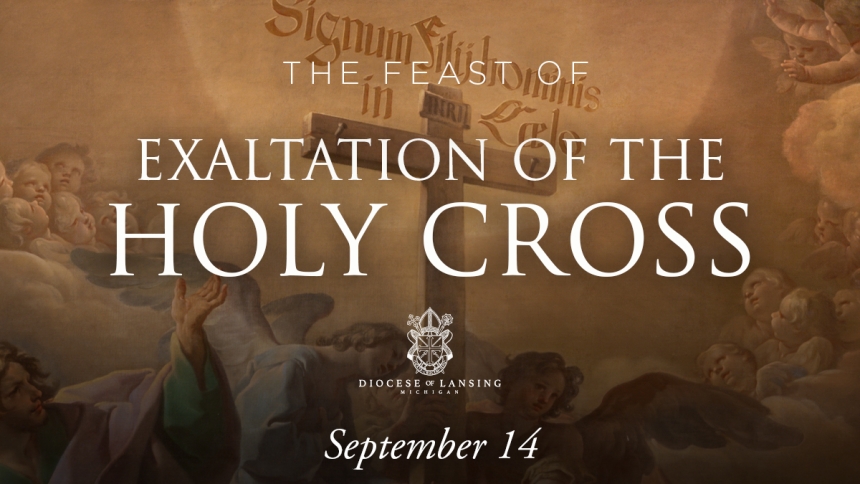
Recently, I visited a new church and as I walked around admiring the artwork and the architecture, I saw on the front of the altar a very familiar symbol, writes Richard Budd, Director of Marriage & Family Life Ministry for the Diocese of Lansing, upon the Feast of the Exultation of the Holy Cross, September 14. Richard continues:
The green marble was emblazoned with the letters IHS. You know the symbol. It often appears on things like altars, or crucifixes, or priests’ vestments, sometimes with a cross coming up out of the H or even as a background to all the letters. My son, who is just learning to read, asked me what the word meant since he couldn’t quite sound it out. I paused, because it was just at that moment when I realized that I didn’t quite know for sure. I knew it had something to do with Jesus, but I wasn’t 100% sure exactly how.
This being the 21st century, I took out my iPhone and we looked it up. It turns out, there are two general theories: the first is that the three letters represent the first three letters in Jesus’ name when spelled in Greek, the second is a fascinating story that includes war, an emperor, and divine intervention.
The Roman Emperor Constantine was embroiled in civil war with another claimant to the throne. The night before a key battle, Constantine received a vision in which he saw the cross with the words In Hoc Signo Vinces (In this sign you will conquer.) Constantine adopted the cross, won the battle, and became sole emperor of Rome. From that time on, Constantine adopted the cross as his standard, and just a few months after the battle, signed the Edict of Milan making Christianity legal in the Roman Empire. The theory of the IHS, then, is that it is an abbreviation of the first three words from the vision: In Hoc Signo.
Interestingly, about fifteen years after this happened, Constantine’s mother Helena became a Christian and made a pilgrimage to Jerusalem where she discovered the Cross of Jesus. Constantine and Helena built the first Church on Calvary and The Holy Sepulcher and spread relics of the Cross throughout the Empire for Christians to venerate. Devotion to the Cross of Christ spread and in the very early centuries of the Church we have records of the Feast of the Exaltation of the Holy Cross which we celebrate on September 14.
Obviously, the Cross as a Christian symbol of faith didn’t start with Constantine. St. Paul boldly proclaimed, “far be it from me to glory except in the cross of our Lord Jesus Christ.” (Galatians 6:14) In another place, Paul says, “we preach Christ crucified, a stumbling block to Jews and folly to Gentiles, but to those who are called, both Jews and Gentiles, Christ the power of God and the wisdom of God.” (1 Cor 1:23-24)
Twenty centuries later, however, we can lose the significance of what the cross meant in these early centuries. The cross was not merely a tool of execution. It was meant to degrade and mock not simply those hanging upon an instrument of torture, but the whole nation Rome ruled over. It reminded the people that they were conquered, that they did not rule themselves, that they were powerless to stop Rome from utterly humiliating them. Crucifixion was so awful that it was actually illegal to crucify a Roman citizen.
So, for the early Christians to claim the Cross as something to boast about and for the Roman army to suddenly emblazon their shields with the sign of the Cross was absolutely astounding. Unthinkable. Jesus took the worst instrument of torture and humiliation ever devised and turned it into the weapon by which he destroyed sin and death forever. The cross is a subversive symbol, but now, it stands athwart the powers of evil, of death, of indifference, and declares allegiance to the God King who lays down his life in love.
This year, especially upon the Exaltation of the Holy Cross on September 14, have as a goal to place a holy cross, a crucifix, in your home as a sign that you follow Christ, that you boast of the victory over sin and death, and as a declaration that these have no power over you and your family. It doesn’t have to be something fancy, the first cross certainly wasn’t.
If you already have a cross in your home and you want to take it up a notch, aim to have a cross in all the principle rooms of the house. If you really want to go for broke, place a cross in every room of the house. We’re talking the laundry room, the foyer, the garage. The goal will be that no matter where you go, you will be able to see the Cross of Jesus.
Christians have never been shy about the Cross of Jesus. As we celebrate this September 14th, let’s recommit to that boldness.
